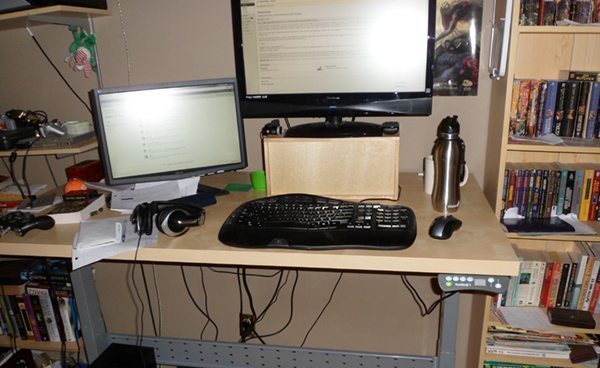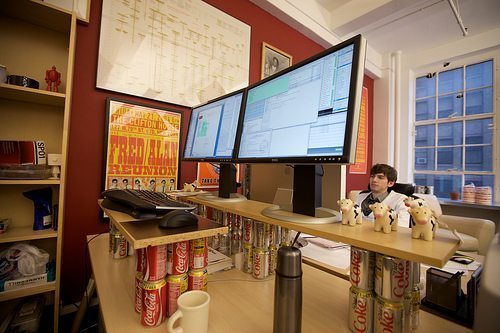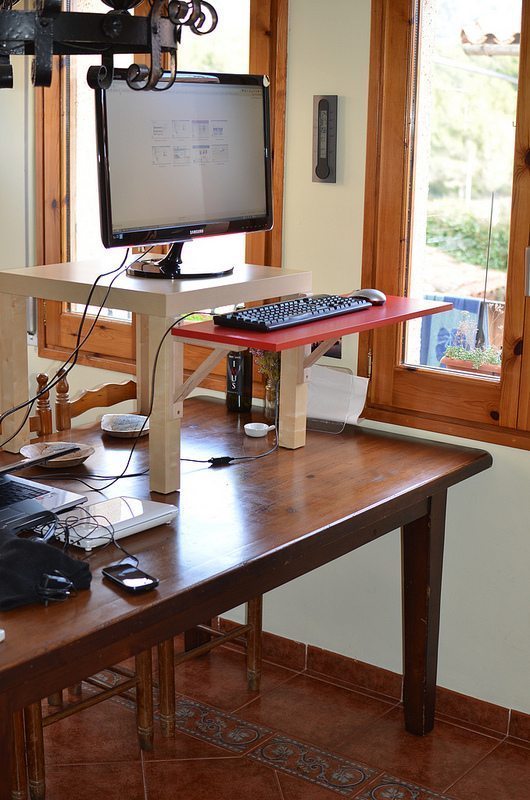
Yes, this is my setup – hopefully you’re not scared of clutter, or this article isn’t getting off to a great start…
The scenario: One lone programmer, sitting in a dark basement, up against the might of the military-industrial complex. Her fingers fly across the keyboard, arcane symbols leaping from mind to screen; her face is locked in an expression of intense concentration, stark in the green phosphorescent glare (our programmer is using an IBM 5151, because this is the future, and that’s what the future looks like – green [See Ghost in the Shell, The Matrix, et al.]).
Maybe, as she types away, a single bead of sweat rolls down her face, past her unblinking eyes. Finally, the code is complete – she takes a deep breath and, hunching over her keyboard, prepares to press ‘Enter’.
Then, her lower back pain flares up from all that sitting and hunching she’s been doing, and she has to go lie down with a hotpack for the next few hours. Alas, passwords go uncracked, mega-corporations untoppled. If only she had been using a standing desk…
Some Science, Some Background
Science: I’m a fairly active guy – hit the gym 6 days out of 7, do some rock climbing and martial art classes. Spending most of the day sitting in front of my keyboard shouldn’t be a problem – I make up for it later. Right?
Looks like that just ain’t so. Sit for most of the day, and you significantly increase your chance of diabetes and cardiovascular disease – even if you sweat a pound off later on in the day. While this wasn’t the reason I switched out desks and all-day sitting marathons, it certainly doesn’t hurt to take it into consideration.
Want that in infographic form? Here ya go. On the house.
Background: So, sitting for extended periods is unhealthy for a variety of reasons, most of which I hadn’t even considered previously. Why did I end up parting with old faithful, the cheap hardboard desk that I’d been using for the last 15 years or so? Well, much like our hacker hero from the intro, hunching over my keyboard was leaving me with an increasingly sore lower back.
In my starving student days, I’d worked in a warehouse and sustained an injury there – nothing serious at the time, but what takes a day with an ice pack to resolve at 19, can put you flat on your back for days later on. As noted above, I like to stay active; but a schedule of sitting 12 hours a day left me with lingering soreness that was starting to hinder my exercise schedule. More than that, twice I managed to pull something in my lower back during cool-down stretches that left me immobile for days at a time. By the time I’d finished the second round of drugs and chiropractor appointments, I knew something had to change.
Musical (expensive) Chairs
A standing desk solution was not the first stop on my mental map from A) Gritting my teeth every time I rolled over in bed to B) Somewhere where anti-inflammatories weren’t needed. Originally, I’d had in mind that I’d just replace my comfortable but not particularly ergonomic chair with a fancy Steelcase, Humanscale or Herman Miller chair. I knew a programmer or two who swore by their Aeron, for instance.
Two things stopped me. One, the price – these chairs are expensive. Very expensive. Now, there is some truth to the saying ‘you get what you pay for’, and if these chairs could spare me some serious discomfort, they would be worth the price of entry. Unfortunately, after trying a number of them in various showrooms near me, I couldn’t really say that any of these $1000+ chairs felt significantly more comfortable than my $50 chair at home. Not exactly a fair shake, I agree – sitting in them for twenty minutes at a showroom isn’t the same as twelve hours at home; but I only had those twenty minutes to make the call. I just wasn’t willing to shell out that kind of money for something that didn’t feel ‘perfect’.
The second thing was that I realized I wasn’t making the fundamental mechanical change that I felt was necessary to resolve my problem – at the end of the day, no matter how expensive my chair is, I’ve still spent the whole day sitting down, and just the idea gave me a little twinge of remembered pain. It was a strange thought when it first occurred to me, but it slowly gathered steam: could I spend the day working – standing up?
Options, options
Oh yes. I’m certainly not the first to have this thought. When I was researching standing desks, I came across all sorts of neat DIY setups using scrounged or cheap materials:
Coke-can stand by Marco:

Or this $22 DIY ikea standing desk (this particular one assembled by utmjording:

I’d actually stumbled across the instructions for that one and, liking the dollar-figure involved, had considered building it (want to take a look at doing the same? Head here to see the instructions).
Alternatively, you could pick up a pre-made solution like the Kangaroo adjustable desk unit, which sits on top of your existing desk in a similar fashion, but can be adjusted to a certain extent without needing to pull out your screwdriver. It’ll run you a few (hundred) dollars more than the Ikea option, though.
Sit Back Down
But on second thought, what if I wanted to sit at some point? I occasionally use my setup for more than work – do I really want to have to stand-up to watch a movie on it, for instance?
Moreover, one of the first things that people ask when they find out I have a standing desk is: don’t your feet hurt? And yes, occasionally – especially at the beginning. Even once your body has started to re-develop some long atrophied muscles, your feet are probably going to be sore (especially if you like to work bare-foot, just because you can). You might need to give in and wear shoes. You might want an anti-fatigue mat.
Or, you might want to give yourself the option to sit down from time to time. This will be especially helpful in the first week or so, when you’re adjusting and questioning whether this whole standing-desk thing was a huge (and painful, time-consuming, expensive) mistake. Sore feet can do that to you.
The least-expensive option is probably buying yourself a tall bar-stool type chair (one that you can adjust up to the appropriate height would probably be perfect).
Or, you can break out the checkbook, and look into the world of adjustable desks.
At the Push of a Button, Plus Tax
This is the route I eventually went down – I’d already reconciled myself with a thousand-dollar plus figure for something, just so long as it could provide me with that fundamental change in stance and behaviour; and I still wanted to be able to sit down the next time I wanted to play a game in much the same way as I always had.
There are some options – the Steelcase Airtouch for instance, or the Anthro Elevate. Both come with strong recommendation by those who have taken the plunge. The former costs about $1500, though, and the latter somewhere around $3000. Unless I could drive the Elevate home, I wasn’t quite ready to shell out that much for it.
Then I came across the Geekdesk. If you’ve been looking into the topic of sit/stand desks, you may have already heard of it. It’s adjustable at a touch, and its ~$1000.
I ended up purchasing the Geekdesk Max frame, and slapping a $40 Ikea desk top on it. Dragged the old desk out, but the new desk together, put it into place – and I probably had a silly grin on my face the first time I watched the desk adjust upwards.
Worth it?
Now, I haven’t exactly been measuring my serum glucose levels every day, so I can’t tell you whether its making a huge difference to my overall health. I can tell you, though, that my back has been thanking me regularly for the change (it does that by not throbbing painfully at the end of each day, you see). The Geekdesk has proven reliable for the year or so I’ve had it, and their customer service responsive. Given that is a premium-priced piece of furniture catering to a niche market, I’d hope and expect the same would be true of the other adjustable desks.
There are a lot of options out there, whether you want to DIY or go all out on an height-adjustable desk. Maybe you even want a treadmill desk? Give the one that appeals most to you a try – if you can get over the first week or so of discomfort, your body will eventually thank you.


